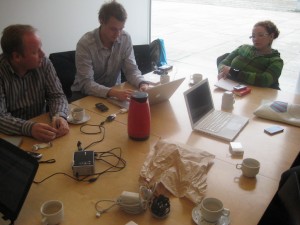#TimeManagement : Five Ways Productive People Manage Time Differently. Great REad for All!
We all know people who manage to get so much more done than the average. They are the high performers at work who have complex jobs with broad scopes of responsibility but manage to stay unflappable. They are the all-stars who excel at work and still stay involved with family, community or in an outside interest.
How do some people accomplish so much more in the same amount of time? What can you do to improve your own productivity? Productive people are not better people – they make better choices and smarter decisions about how they spend their time.
Here are five ways productive people manage time differently:
1 – Focus on what matters
Productive people are clear about their most important priorities – on the job and in their lives. Today’s work environment is busy for everyone. Rapid change is the norm. Too little time describes almost everyone’s regular experience. Productive people don’t try to do everything or even a lot of things by quantity, but they focus their time on quality – i.e., what will have the most impact.
You too should prioritize your list of everything you need to do in terms of what will have the most impact on your professional and personal goals. In this time of high unemployment, you may want to focus on shoring up your on-the-job performance (use this job security checklist to gauge how you are doing). Or you may be going for a promotion, in which case, you want to align your priorities with what your manager and senior leaders prioritize (and therefore notice).
Like this Article? Share It! You now can easily enjoy/follow/share Today our Award-Winning Articles/Blogs with Now Over 2.5 Million Growing Participates Worldwide in our various Social Media formats below:
LinkedIn: https://www.linkedin.com/in/chris-g-laughter-b46389198/
Facebook: http://www.facebook.com/pages/First-Sun-Consulting-LLC-Outplacement-Services/213542315355343?sk=wall
Twitter: Follow us @ firstsunllc
Best Daily Choice: Follow the Best of FSC Career Articles/Blogs @
https://twitter.com/search?q=bestoffscblog&src=typeahead_click
Question: Want the ‘the best/current articles/blogs on the web’ on Job Search, Resume, Advancing/Changing your Career, or simply Managing People?
Answer: Simply go to our FSC Career Blog below & Type(#Jobsearch, #Resume, or #Networking) in Blog Search: https://www.firstsun.com/fsc-career-blog/
What Skill Sets Do You have to be ‘Sharpened’ ?
Article continued …
2 – Stay focused despite distractions
Once you are clear about what matters, you still need to actually spend your time on these priorities. Productive people know how to stay focused despite distractions. There are many distractions in the workplace – meetings, interruptions by colleagues, another project or task that arises. Hoping for fewer distractions is less realistic than training yourself to stay focused and say No even in the workplace.
If you are already clear on your priorities but find it difficult to stay focused on them, block out time first thing in your day for your most important work. Distractions will have less time to build up first thing in the morning, and if you are pulled away, you have the rest of the day to make up the time. Or try changing your work environment to signal to yourself and others that you should not be disturbed (at home, this could simply be moving to another space in the same room).
3 – Course-correct when things go wrong
The best laid plans can still go wrong – there might be an urgent task that rightly takes you away from your priority work time. However, rather than just scrambling the rest of the day or week hoping to catch up, the productive person will take a pause and readjust the remaining time around the priorities. The block of time reserved for priority work will get moved to another sacred time. The busywork will be what gets postponed.
To keep on track, set visible metrics for your priorities so you can readily see where you are and how much catching up you need to do. I once coached a project leader who was busily coordinating with 50+ colleagues on a policy rollout. The deadline was in 10 weeks, and her team was working on a pace that accommodated just two to three colleagues per week. At that pace, they would not finish, so something would have to change. Having a clear metric and deadline enabled the project leader to catch the problem early enough that they could refine the rollout going forward and make up some ground.
4 – Invest time in planning
That extra time to redo a rollout plan or to reschedule your day after an interruption is an investment. Productive people invest time in planning. They are disciplined enough to recognize that the time they use to plan is time they will get back and more by correctly identifying what needs to be done, when and how.
If your natural tendency is to dive into a big project, schedule time in the first week for planning. On an ongoing basis, reserve time on Sunday or Monday to sketch out your week, Wednesday for midweek adjustments and/or Friday to digest how the week has gone and what s a priority for the following week. Finally, set calendar appointments on a monthly and quarterly basis to check in on your longer-term goals that might not have firm timetables – e.g., tending to your network, increasing your emergency fund.
5 – Reserve and protect down time
Counterintuitively, one way to get more done is to work less. Productive people take regular breaks, both short rests throughout the day and longer periods of time away (This Psychology Today post is a great summary on the science behind why breaks improve performance.)
You may need to plan your breaks if you tend to just plow through your day and even work through lunch. Set up lunch dates with other people (even if it’s a virtual date) to ensure you stop work for at least a few minutes. Set an alarm every 25-50 minutes to take a short break – stand up and stretch, drink a glass of water, even just close your eyes and do some deep breaths. Block out vacation time over the next three to six months – it will give you something to look forward to and it will give your workplace ample time to make coverage arrangements.
Productivity is about behaviors not qualities
Remembering that productivity is about the actions you take and not the person you are means that productivity is a learned skill, not something you are born with. Even if you weren’t productive before, you can start today to take smarter actions, change your behavior, and improve your productivity.
Forbes.com | June 21, 2020 | Caroline Ceniza-Levine

















